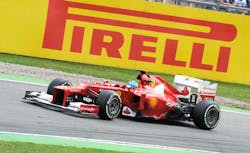Formula One heads to the German Grand Prix this weekend, which alternates each year between the Nurburgring and Hockenheim. This year it is the turn of Hockenheim, last used in 2012: only Pirelli’s second year in Formula One. Hockenheim is really a circuit of two halves: a tight and twisty stadium section, which is quite technical, then a fast series of straights.
The P Zero Yellow soft tire has been selected alongside the P Zero Red supersoft: a combination last used in Austria. Just like Austria and Silverstone, weather conditions in the upper Rhine valley can be unpredictable at this time of year, with a wide range of temperature variations possible. Following the German Grand Prix, the teams will go straight to Hungary (where the soft and medium tires are nominated): the first and only back-to-back race weekends in Europe this year.
Paul Hembery, Pirelli motorsport director:
“It’s a pleasure to go back to Hockenheim after two years away, but this increases the workload for ourselves and the teams as the only concrete F1 data we currently have is two years old – when the cars and the tires were very different. So we expect the Friday free practice sessions to be extremely important, as the teams use the time to assimilate as much relevant information as they can. We’ve never been to Hockenheim with the supersoft before, but now that we have collected more data on the compounds this year, we think it should be well-suited to the varying demands of Hockenheim, which used to be one of the fastest circuits in the world, before it was modified in 2002. By Friday afternoon, we should have a clearer idea of how many pit stops we might expect. Germany has always been at the heart of not just Formula One but the automotive industry as a whole, so we’re looking forward once more to showcasing our products in front of the extremely enthusiastic and knowledgeable German fans.”
The circuit from a tire point of view:
Traction and braking are the two key aspects of Hockenheim, with the tires subjected to deceleration forces of almost 5g. The slow stadium section, with lots of acceleration out of slow corners, means that the drivers have to be careful to avoid wheelspin, which will heat up the surface of the compound.
The supersoft tire is a low working range compound, capable of achieving optimal performance even at a wide range of low temperatures. The soft tire is a high working range compound, suitable for higher temperatures and more strenuous track conditions. At Hockenheim, an ample variety of weather is possible, with early indications suggesting some showers over the weekend.
The relatively low average temperatures and short corners make keeping the tires within their ideal working range one of the biggest challenges at Hockenheim. This is essential to generate optimal grip on the smooth asphalt, which generally does not take a lot of energy out of the tires. Turn 5, however, which is almost a straight line, puts a lot of energy on the right-hand side.
The winning strategy in 2012 was two stops, with the soft and medium tires allocated. Ferrari’s Fernando Alonso controlled the race from pole, only losing the lead during his pit stops, which he regained as the result of his strategy.



